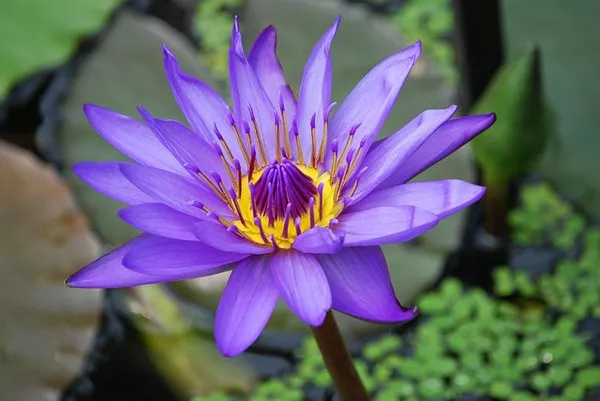Lily of the Valley (Convallaria majalis) is a delicate and enchanting perennial that captivates garden enthusiasts with its fragrant, bell-shaped flowers and lush green foliage. While its blooming period is relatively short, lasting only a few weeks in spring, the beauty of these dainty blossoms is a sight to behold. However, once the blooms begin to fade, gardeners often wonder what to do with their lily of the valley plants. In this article, we will explore the best practices for caring for lily of the valley after flowering to ensure their continued health, vitality, and, of course, future blooms.
Allow the Foliage to Wilt Naturally
As the lily of the valley flowers start to fade, it is essential to allow the foliage to wither and turn yellow naturally. The leaves play a crucial role in the plant’s energy storage and rejuvenation process. During this post-flowering period, the leaves continue to photosynthesize and store energy for the following year’s growth. Prematurely removing the foliage can deprive the plant of the energy it needs for a robust comeback in the next spring.
While the yellowing leaves may not look their best, patience is key. You can disguise the unsightly foliage by planting other low-growing perennials or ground covers around the lily of the valley. This will help maintain the aesthetics of your garden while allowing the lily of the valley to complete its natural life cycle.
Groom and Tidy Up
To maintain a tidy and healthy garden, it’s essential to keep your lily of the valley bed well-groomed. After the foliage has fully yellowed, you can gently trim it back to ground level. However, be cautious not to damage the emerging shoots or disturb the rhizomes beneath the soil. A sharp pair of scissors or pruning shears is recommended for this task.
By tidying up the spent foliage, you not only enhance the garden’s appearance but also reduce the risk of potential diseases and pests harboring within the decaying leaves. Proper grooming also prevents the plants from self-seeding excessively, which can lead to overcrowding and competition for resources.
Divide and Conquer
Over time, lily of the valley plants can become overcrowded, resulting in reduced flower production and smaller, less vigorous plants. The ideal time to divide your lily of the valley is during the early autumn, after the foliage has withered. Dividing your plants every three to four years helps maintain their vitality and encourages more robust growth and blooming.
To divide your lily of the valley, follow these steps:
a. Dig up the entire clump of lily of the valley, carefully loosening the soil around the roots to avoid damaging them.
b. Gently separate the rhizomes and roots into smaller sections. Each division should have a few healthy roots and at least one growing point (an emerging shoot).
c. Replant the divisions at the desired spacing, ensuring they are at the same depth as they were previously. Water them thoroughly after planting.
Dividing your lily of the valley not only revitalizes the plants but also provides an opportunity to expand your garden or share these charming plants with fellow gardeners.
Mulch for Winter Protection
To safeguard your lily of the valley during the harsh winter months, consider applying a layer of organic mulch around the plants. A protective mulch, such as shredded leaves, straw, or compost, should be spread to a depth of approximately 2 inches. This helps insulate the soil, regulate temperature fluctuations, and maintain soil moisture levels.
The mulch also acts as a natural weed suppressant and further enhances the overall appearance of your garden. Be sure to avoid placing mulch directly on top of the emerging shoots, as this could hinder their growth. Leave a small, clear area around each plant to ensure they have room to push through in spring.
Fertilize Sparingly
Lily of the valley is not particularly demanding when it comes to fertilization. In most cases, they can thrive in soil with adequate organic matter. However, a light application of a balanced, slow-release fertilizer in early spring can provide a gentle nutrient boost to support growth and flowering.
Choose a fertilizer with equal or near-equal ratios of nitrogen, phosphorus, and potassium (N-P-K), such as a 10-10-10 blend, and apply it according to the manufacturer’s instructions. Remember that over-fertilization can lead to excessive foliage growth at the expense of flowering, so use fertilizers sparingly.
Control Invasive Spread
While lily of the valley’s charm is undeniable, it can become invasive in certain conditions. This is especially true if it escapes into natural ecosystems, where it can outcompete native plants. To prevent invasive spread, take these precautions:
Plant lily of the valley in contained garden beds or pots, limiting their ability to spread through underground rhizomes.
Regularly monitor your garden for any unwanted seedlings or rhizomes that have traveled beyond their designated area.
Share extra lily of the valley divisions with neighbors or friends, but do so with care, ensuring they understand the plant’s potential invasiveness and are willing to manage it responsibly.
Conclusion
Lily of the Valley is a garden favorite for its delicate beauty and captivating fragrance. Caring for these enchanting plants after they have finished flowering is essential to ensure their continued health and the prospect of future blooms. By allowing the foliage to wither naturally, tidying up, dividing when needed, applying protective mulch, and practicing responsible garden management, you can keep your lily of the valley thriving year after year. With the right care and attention, your garden will continue to be graced by the charming presence of this perennial beauty.


